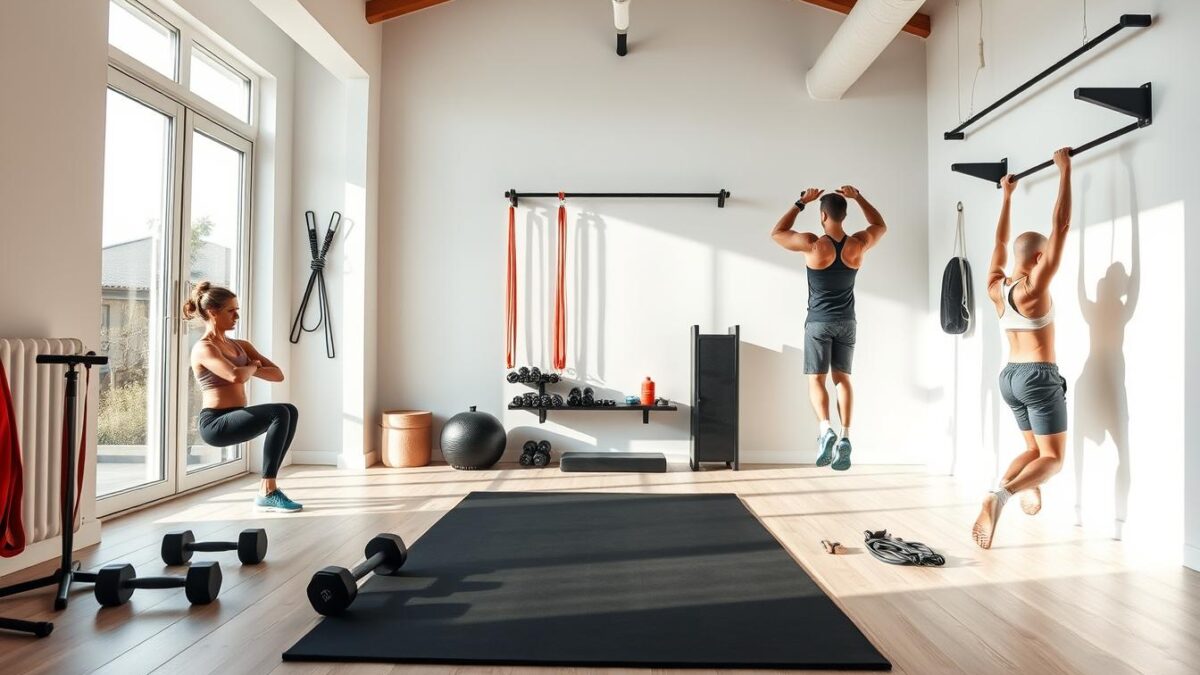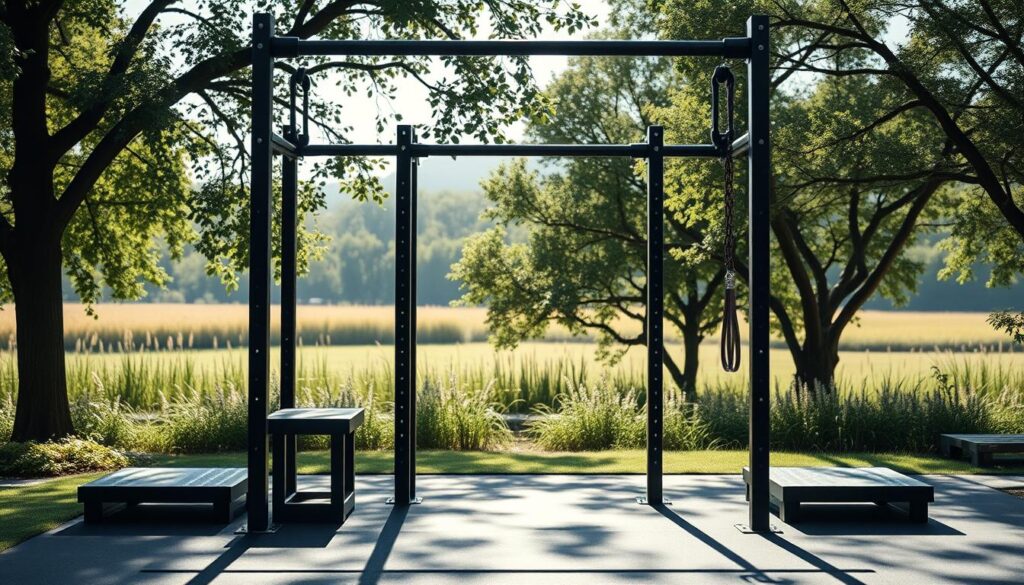
Minimal-Equipment Strength Routine Under 30 Minutes
Do you find it hard to fit in strength training with your busy life? This minimal-equipment routine is perfect for anyone wanting to build muscle and boost endurance. It’s quick and can be done at home with just a few pieces of equipment or even your own body weight.
Discover how to use strength training at home with minimal gear. It makes getting fit easier and more enjoyable.
Introduction to Strength Training at Home
Strength training at home is a great way to stay fit without needing a gym. It’s perfect for those with busy schedules or limited access to gyms. You can work out in your own space with just a few simple exercises and some basic equipment.
Doing strength training at home can make you stronger and happier. It can also give you more energy all day. You don’t need a gym to stay fit; your living room or backyard will do. This way, you can easily take care of your health and well-being.
The Benefits of Minimal-Equipment Workouts
Minimal-equipment workouts have many advantages that can change your fitness journey. They are very convenient. You can start exercising in just a few minutes, fitting it easily into your day.
These workouts are also very efficient. They help you get stronger and improve your heart health in short sessions. Perfect for busy people, they let you boost your fitness without spending hours at the gym. Their simplicity also encourages creativity, pushing you to use what you have in new ways.
Another great thing about minimal-equipment workouts is they help you stay consistent. Knowing you can exercise anywhere boosts your motivation. Adding these workouts to your daily routine improves your physical and mental health, helping you reach your fitness goals with confidence.
Creating a Minimal-Equipment Strength Routine
Starting a minimal-equipment strength routine begins with knowing your fitness goals. Understanding what you want to achieve is key. It helps shape your workout plan, whether you’re looking to get stronger, last longer, or lose weight.
Understanding Your Goals
Setting fitness goals is more than motivation; it guides your training. Think about what you want to achieve. If you want to build muscle, focus on strength exercises. For losing fat, add more dynamic movements and higher reps.
Knowing your goals helps tailor your workouts. It keeps you focused and interested in your fitness journey.
Selecting the Right Equipment
Choosing the right equipment is the next step. Options like dumbbells, resistance bands, and kettlebells offer flexibility. For example, dumbbells work on different muscles, while kettlebells improve coordination and strength.
By picking the right gear, you make sure each workout helps you reach your goals. This makes your fitness routine not only effective but also fun.
Essential Equipment for Effective Workouts
To build strength at home, think about using dumbbells and kettlebells. These tools let you do many exercises, hitting different muscles. They help you increase workout intensity and adjust to your fitness level and goals.
Dumbbells and Kettlebells
Dumbbells are key in many workouts, being easy to use and versatile. They let you do exercises like bicep curls and squats, working many muscles. Kettlebells add dynamic moves like swings, boosting heart health and strength.
Bodyweight Exercises
Bodyweight exercises are also powerful. Push-ups, squats, and lunges build strength without equipment. Learning these exercises improves your fitness without extra gear. Mixing bodyweight exercises with equipment gives you a full workout, keeping it simple.
The Structure of an Effective Routine
Creating a workout structure that boosts strength training is key. Circuit training is often used, letting you move from one exercise to the next. This method raises your heart rate and makes the most of your time.
To have a balanced strength training routine, include exercises for the upper body, lower body, and core. This mix ensures all muscles get a good workout.
Don’t forget warm-up and cool-down periods. They help with recovery and prevent injuries. A well-rounded routine keeps you motivated and on track with your fitness goals.
| Component | Description |
|---|---|
| Warm-Up | 5-10 minutes of light cardio and dynamic stretches to prepare the body. |
| Upper Body Workout | Include exercises like push-ups or dumbbell rows for upper body strength. |
| Lower Body Workout | Incorporate squats or lunges to target lower body muscles. |
| Core Workout | Engage with planks or Russian twists for a strong core. |
| Cool-Down | 5-10 minutes of stretching and deep breathing to promote recovery. |

Sample Minimal-Equipment Strength Routine Under 30 Minutes
Are you ready for a quick yet effective workout? This routine fits in 30 minutes, perfect for those with busy lives. It starts with warm-up exercises to get you ready. Then, it moves to a full-body circuit that works many muscles.
Warm-Up: Getting Ready to Train
Before starting your workout, it’s key to warm up. This prevents injuries and boosts your performance. Here’s a simple warm-up routine:
- Brisk walking or jogging in place for 5 minutes
- Dynamic stretches such as arm circles and leg swings for 5 minutes
- Bodyweight squats or lunges to activate your legs
Example Circuit: Full Body Routine
This full-body circuit uses basic exercises that need little equipment. Work for 30 seconds, then rest for 15 seconds. Do the circuit three times for a well-rounded workout.
| Exercise | Sets | Reps/Duration |
|---|---|---|
| Push-Ups | 3 | 30 seconds |
| Dumbbell Rows | 3 | 30 seconds |
| Bodyweight Squats | 3 | 30 seconds |
| Plank | 3 | 30 seconds |
| Jumping Jacks | 3 | 30 seconds |
By following these warm-up exercises and the full-body circuit, you’ll make the most of your workout time. These steps will energize your routine and boost your fitness journey.
Minimal-Equipment Strength Routine: Timing Is Key
Getting your workout timing right is key to reaching your fitness goals. Focus on how intense your workout is, not how long it lasts. This way, you get the most out of every minute, without needing to spend hours at the gym.
Try using set times for each exercise and rest. For example, do each exercise for 30 seconds, then rest for 15 seconds. This keeps your heart rate up and builds endurance. It makes your workouts efficient and helps you gain strength without feeling rushed.
Here’s a quick reference table that showcases how to structure your timing during a typical session:
| Activity | Duration | Focus |
|---|---|---|
| Warm-Up | 5 minutes | Prepare body and joints |
| Exercise Interval | 30 seconds | Maximize intensity |
| Rest Period | 15 seconds | Recover and reset |
| Repeat Cycles | 3-4 cycles | Complete workout |
| Cool Down | 5 minutes | Lower heart rate |
Mastering your workout timing is the first step to achieving your strength goals. It helps you fit your workouts into a busy schedule. This approach makes your sessions more productive and turns fitness into a well-timed art form.
Tips for Maximizing Your Workout
Getting the most out of your workout is key to reaching your fitness goals. Using effective workout tips can greatly improve your performance and results. Focus on proper form and technique to avoid injuries and get the most from each exercise. Knowing how to manage rest periods helps keep your workout intensity high, leading to better gains and efficiency.
Focus on Form and Technique
Putting form and technique first is vital for any workout. Correct positioning boosts performance and targets the right muscle groups. Important things to remember include:
- Engaging the core to stabilize movements.
- Maintaining proper joint alignment to avoid strain.
- Performing exercises slowly to maximize control.
By following these tips, your workouts will be safer and more effective, helping you perform better.
Rest Period Management
Strategically managing your rest periods can boost your workout efficiency. Good rest helps you recover and stay energized for intense exercises. Here are some ways to optimize your rest:
- Keep rest times between sets to 30-90 seconds, depending on intensity.
- Use active recovery, like light stretching, during rest intervals.
- Stay hydrated to keep energy levels up.
Using these strategies will help keep your workout intensity high and ensure you get the most from each session.
Adjusting Your Routine for Different Goals
To reach your fitness goals, it’s key to adjust your routine. Whether you want to build muscle, increase endurance, or lose weight, a tailored training plan is vital. Knowing how to change volume, intensity, and frequency is important for success.
Watching your progress is a great way to make changes. By seeing how your body reacts to workouts, you can find what works best. For muscle growth, you might need to lift heavier or do more sets. For weight loss, adding HIIT can help raise your metabolism.
Personalized fitness keeps you motivated. Being able to change your routine keeps you interested and committed. Using rep range guidelines can help you adjust your workouts to meet your changing goals.
Common Mistakes to Avoid
Many people make big mistakes in their workouts. These errors can slow down progress and cause injuries. It’s important to know these common mistakes to have a safer and more effective workout.
One big mistake is skipping warm-up routines. Not getting your body ready can lead to injuries. This stops you from reaching your fitness goals.
Another mistake is doing exercises with the wrong form. Bad technique makes workouts less effective and can cause problems. It’s key to strengthen muscles while keeping movements right.
Here are a few workout mistakes to watch out for:
- Skipping warm-up and cool-down phases
- Using weights that are too heavy
- Rushing through exercises without focusing on form
- Ignoring body signals of fatigue or pain
By knowing these mistakes and making changes, you can improve your workout. Listen to your body and remember, fitness is a journey, not a race.
Tracking Progress and Staying Motivated
Tracking your progress is key to a good fitness plan. It keeps your goals in sight and reachable. This habit boosts your motivation and lets you celebrate small wins.
Whether you like a simple journal or a high-tech app, find what works for you. It makes a big difference.
Being part of a fitness community adds extra motivation. Workout buddies or online groups offer support and encouragement. Together, you can overcome challenges and stay on track with your goals.
Motivation can change, and that’s okay. Watching your progress and being with supportive people helps you stay strong. Focus on your journey, keep tracking, and celebrate every step forward.



